Abstract
beta-Hydroxyaspartic acid is a post-translationally modified amino acid found in a number of plasma proteins in a domain homologous to epidermal growth factor. Its presence can be correlated with a high affinity Ca2+ binding site, with a dissociation constant of 10-100 microM. We describe a system for the expression of human coagulation factor IX in dog kidney cells in tissue culture, in which the post-translational modifications and the biochemical activity are indistinguishable from factor IX synthesized in vivo. This system has been used to express eight different point mutations of human factor IX in the first epidermal growth factor domain in order to study the role of beta-hydroxyaspartate at residue 64, and the adjacent carboxylate residues at positions 47, 49 and 78. We conclude that this domain is essential for factor IX function and suggest that Ca2+ binds to carboxylate ions in this domain and stabilizes a conformation necessary for the interaction of factor IXa with factor X, factor VIII and phospholipid in the next step of the clotting cascade.
Full text
PDF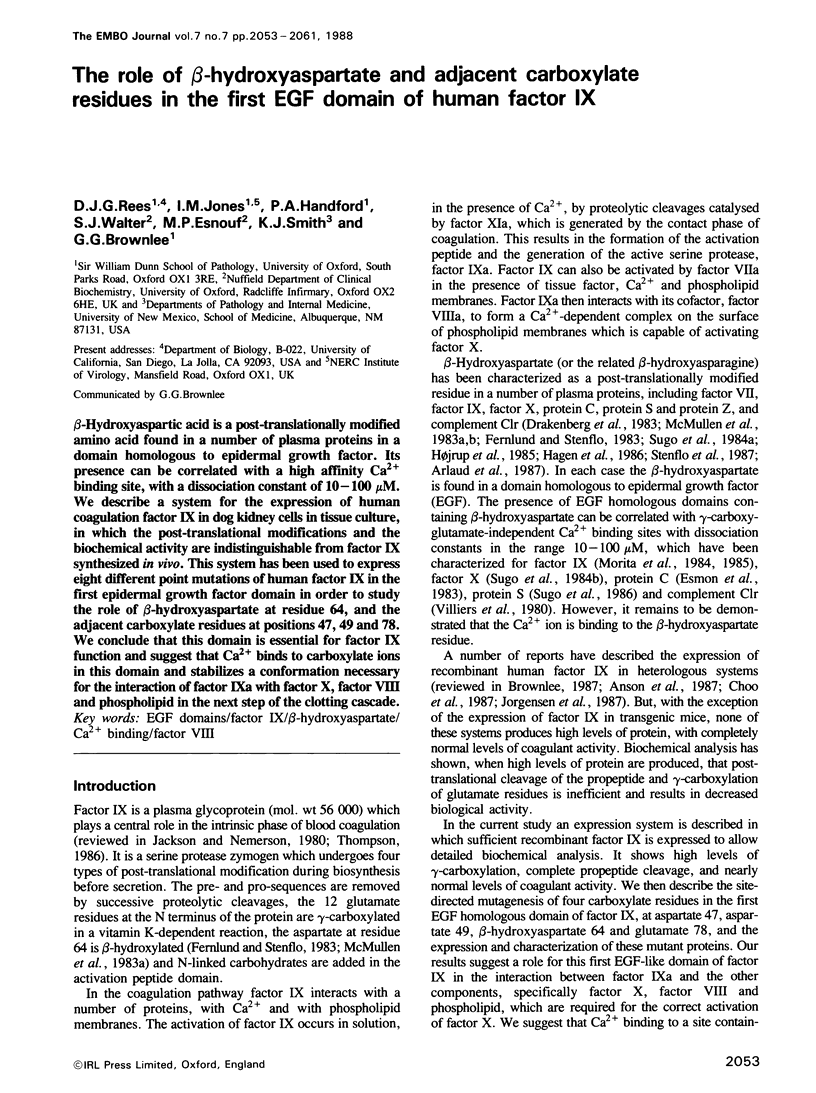
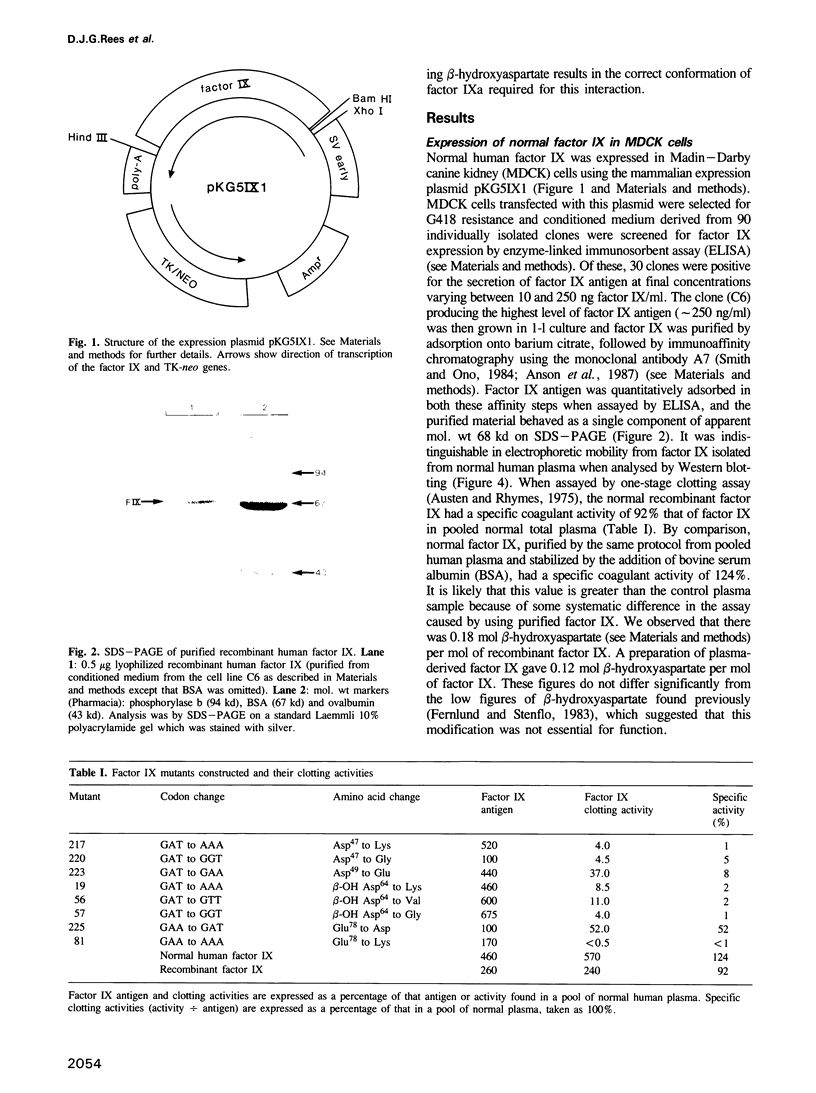
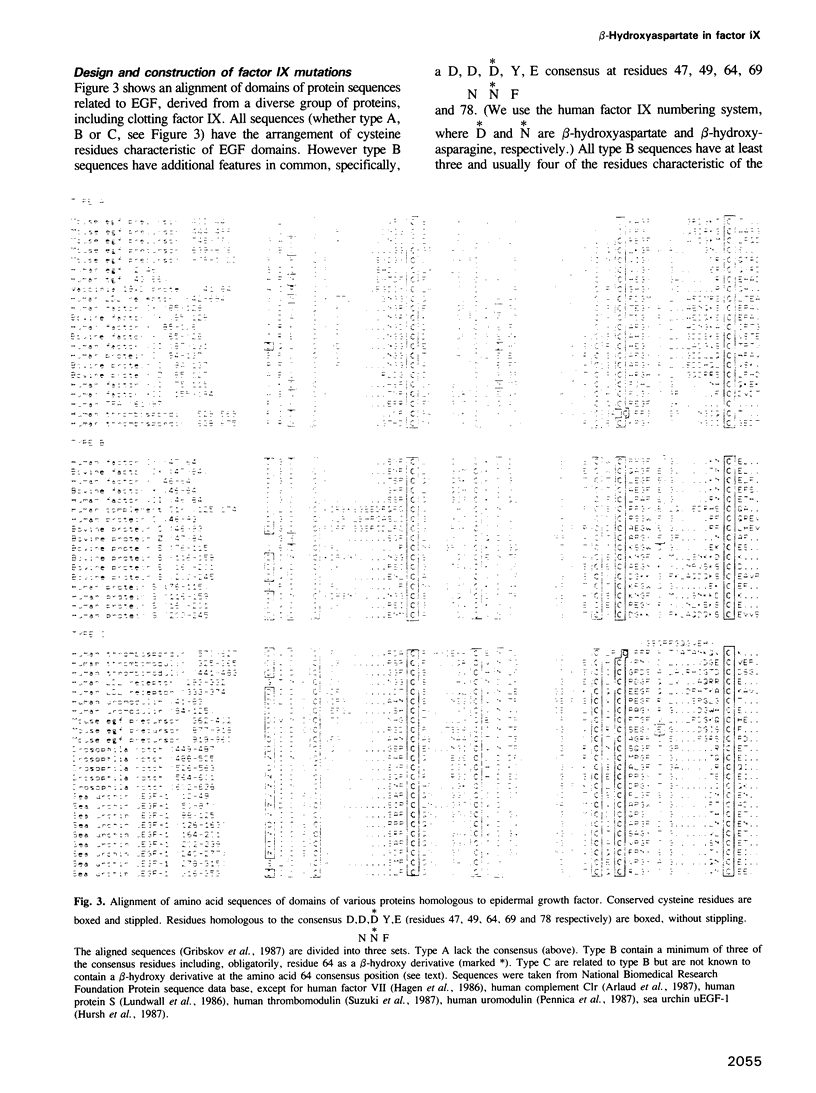
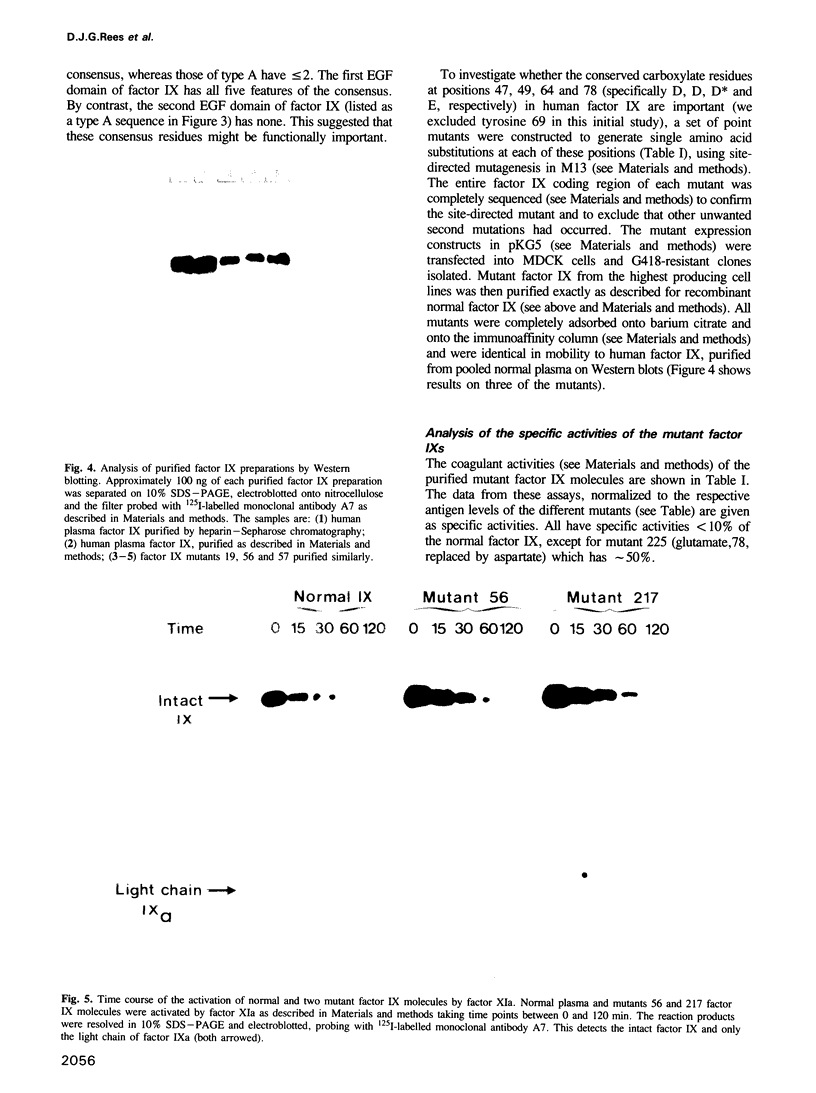
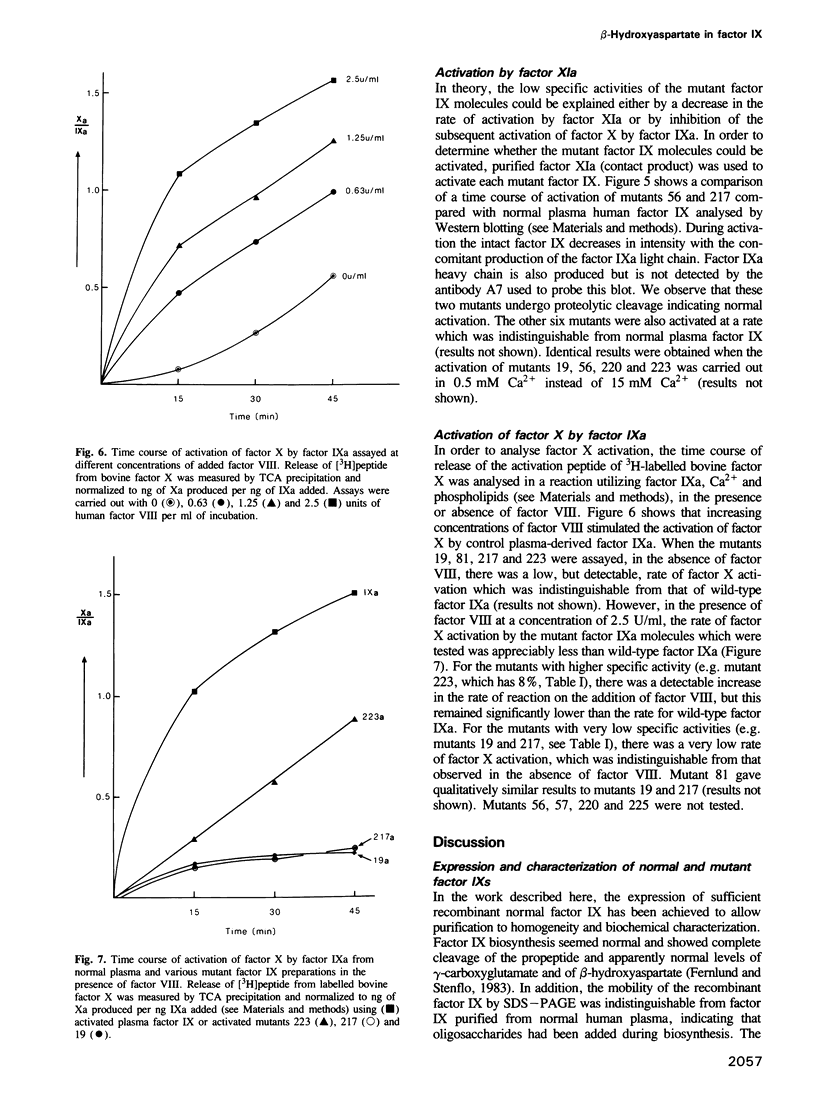
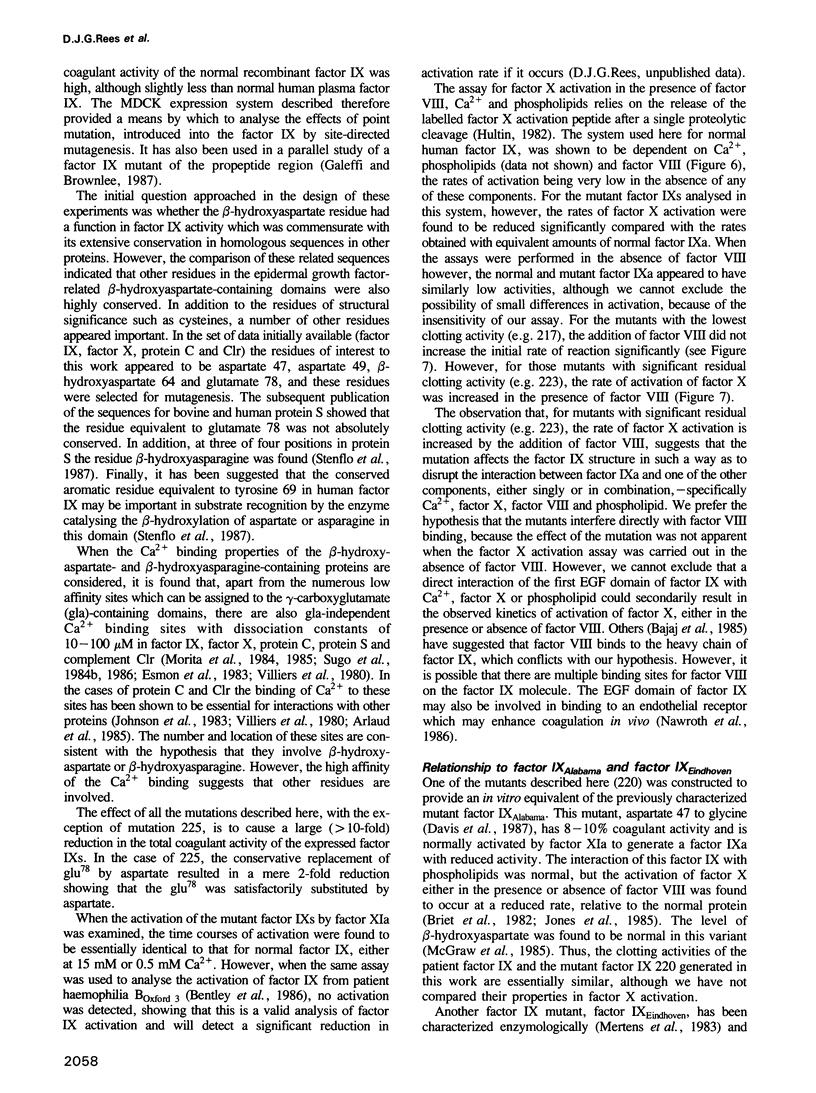
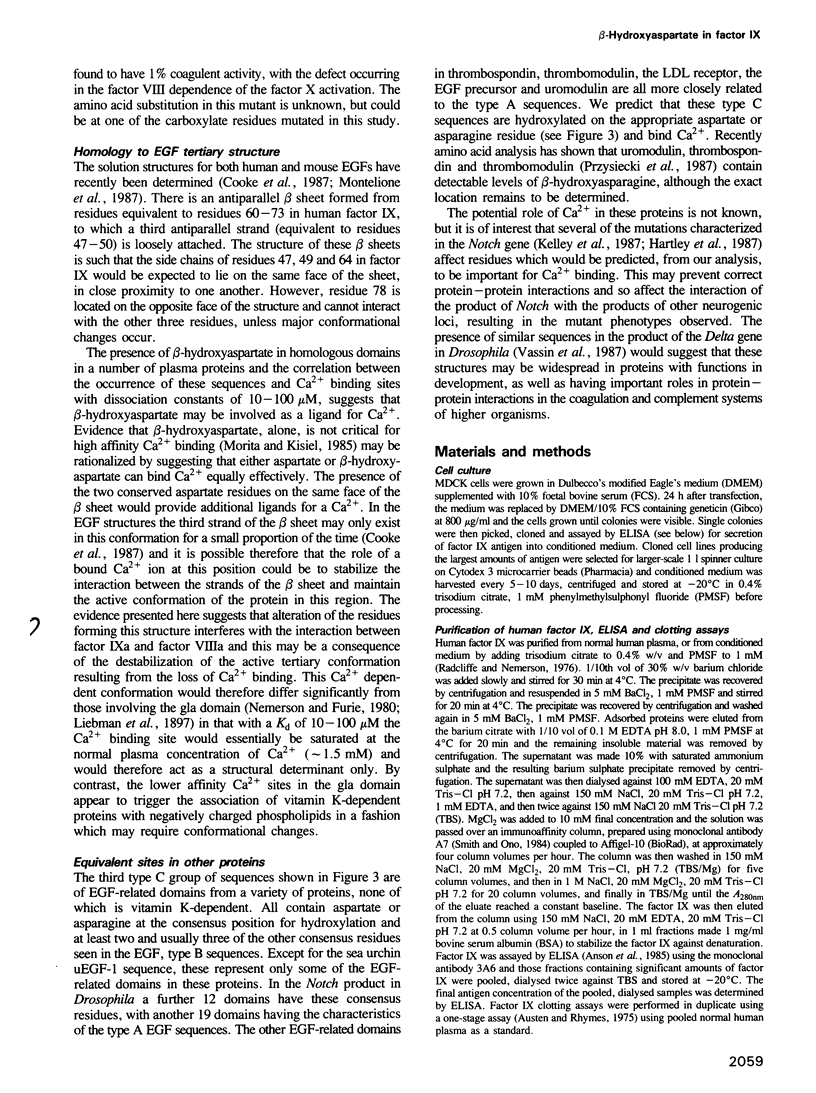
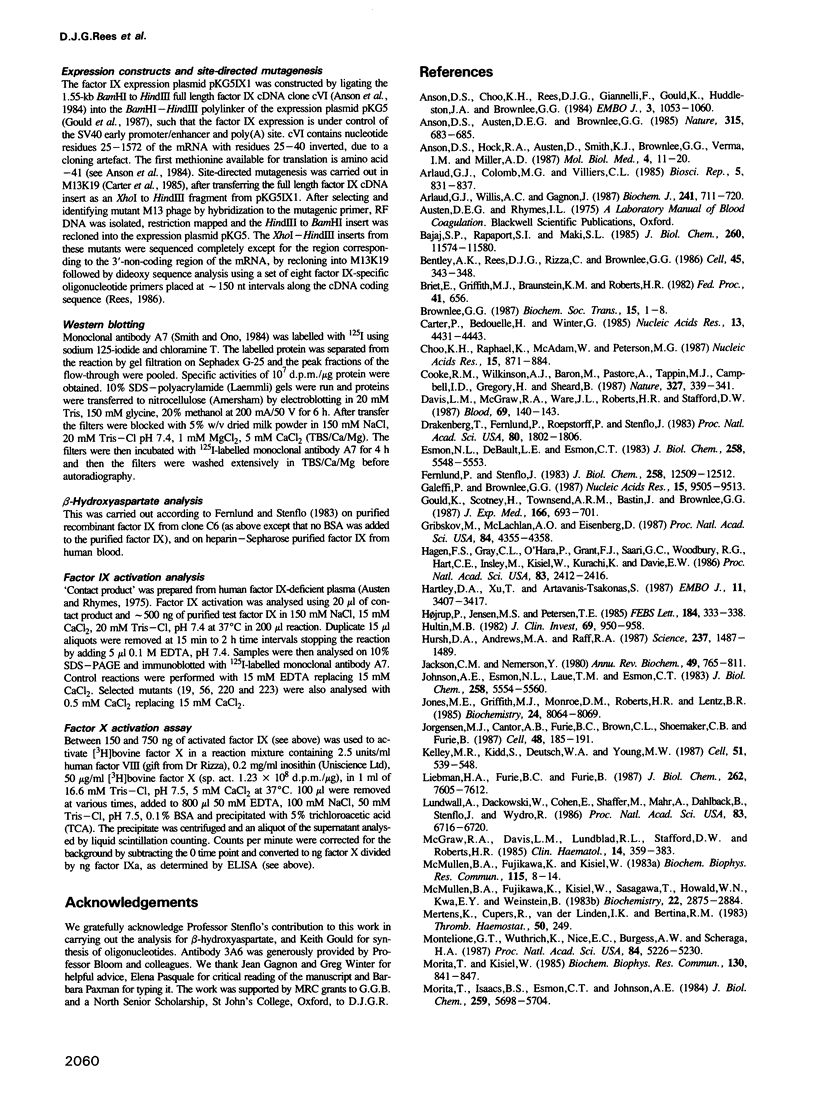
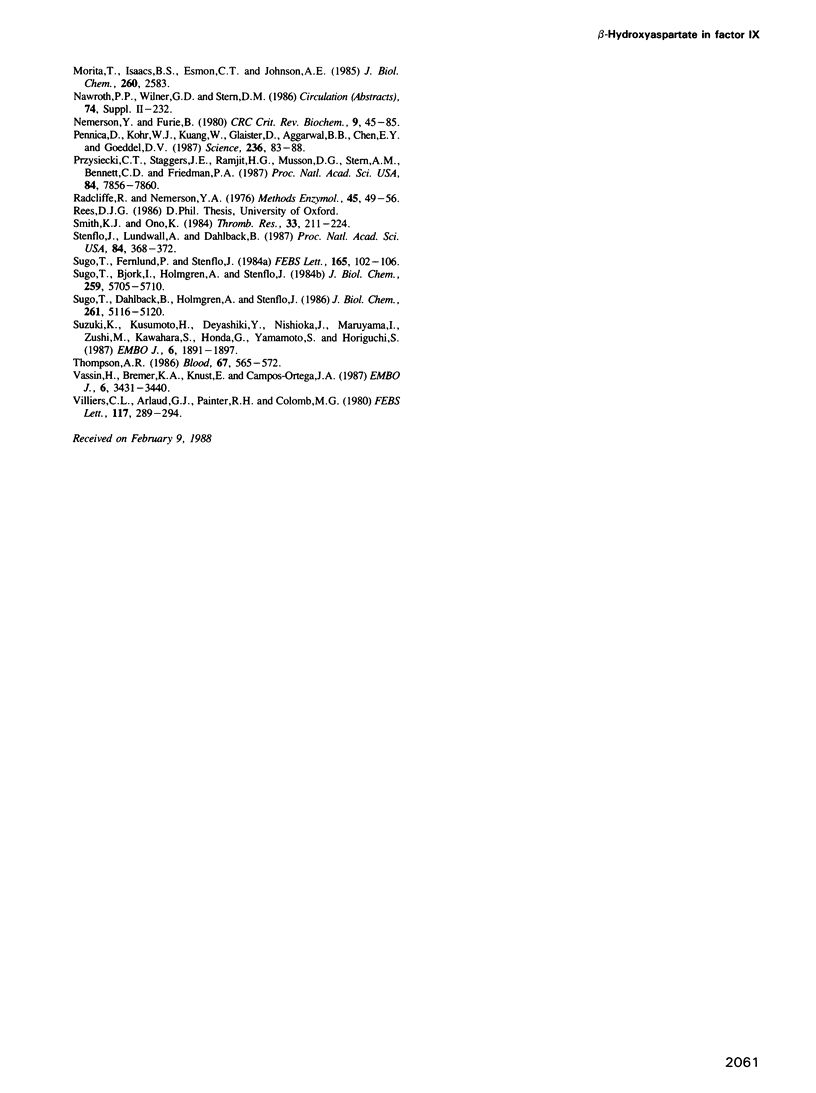
Images in this article
Selected References
These references are in PubMed. This may not be the complete list of references from this article.
- Anson D. S., Austen D. E., Brownlee G. G. Expression of active human clotting factor IX from recombinant DNA clones in mammalian cells. Nature. 1985 Jun 20;315(6021):683–685. doi: 10.1038/315683a0. [DOI] [PubMed] [Google Scholar]
- Anson D. S., Choo K. H., Rees D. J., Giannelli F., Gould K., Huddleston J. A., Brownlee G. G. The gene structure of human anti-haemophilic factor IX. EMBO J. 1984 May;3(5):1053–1060. doi: 10.1002/j.1460-2075.1984.tb01926.x. [DOI] [PMC free article] [PubMed] [Google Scholar]
- Anson D. S., Hock R. A., Austen D., Smith K. J., Brownlee G. G., Verma I. M., Miller A. D. Towards gene therapy for hemophilia B. Mol Biol Med. 1987 Feb;4(1):11–20. [PubMed] [Google Scholar]
- Arlaud G. J., Colomb M. G., Villiers C. L. C1r serine proteinase of human complement: a case of intramolecular autolytic activation. Biosci Rep. 1985 Oct-Nov;5(10-11):831–837. doi: 10.1007/BF01119894. [DOI] [PubMed] [Google Scholar]
- Arlaud G. J., Willis A. C., Gagnon J. Complete amino acid sequence of the A chain of human complement-classical-pathway enzyme C1r. Biochem J. 1987 Feb 1;241(3):711–720. doi: 10.1042/bj2410711. [DOI] [PMC free article] [PubMed] [Google Scholar]
- Bajaj S. P., Rapaport S. I., Maki S. L. A monoclonal antibody to factor IX that inhibits the factor VIII:Ca potentiation of factor X activation. J Biol Chem. 1985 Sep 25;260(21):11574–11580. [PubMed] [Google Scholar]
- Bentley A. K., Rees D. J., Rizza C., Brownlee G. G. Defective propeptide processing of blood clotting factor IX caused by mutation of arginine to glutamine at position -4. Cell. 1986 May 9;45(3):343–348. doi: 10.1016/0092-8674(86)90319-3. [DOI] [PubMed] [Google Scholar]
- Brownlee G. G. The molecular pathology of haemophilia B. Fourth Wellcome Trust lecture. Biochem Soc Trans. 1987 Feb;15(1):1–8. doi: 10.1042/bst0150001. [DOI] [PubMed] [Google Scholar]
- Carter P., Bedouelle H., Winter G. Improved oligonucleotide site-directed mutagenesis using M13 vectors. Nucleic Acids Res. 1985 Jun 25;13(12):4431–4443. doi: 10.1093/nar/13.12.4431. [DOI] [PMC free article] [PubMed] [Google Scholar]
- Choo K. H., Raphael K., McAdam W., Peterson M. G. Expression of active human blood clotting factor IX in transgenic mice: use of a cDNA with complete mRNA sequence. Nucleic Acids Res. 1987 Feb 11;15(3):871–884. doi: 10.1093/nar/15.3.871. [DOI] [PMC free article] [PubMed] [Google Scholar]
- Cooke R. M., Wilkinson A. J., Baron M., Pastore A., Tappin M. J., Campbell I. D., Gregory H., Sheard B. The solution structure of human epidermal growth factor. 1987 May 28-Jun 3Nature. 327(6120):339–341. doi: 10.1038/327339a0. [DOI] [PubMed] [Google Scholar]
- Davis L. M., McGraw R. A., Ware J. L., Roberts H. R., Stafford D. W. Factor IXAlabama: a point mutation in a clotting protein results in hemophilia B. Blood. 1987 Jan;69(1):140–143. [PubMed] [Google Scholar]
- Drakenberg T., Fernlund P., Roepstorff P., Stenflo J. beta-Hydroxyaspartic acid in vitamin K-dependent protein C. Proc Natl Acad Sci U S A. 1983 Apr;80(7):1802–1806. doi: 10.1073/pnas.80.7.1802. [DOI] [PMC free article] [PubMed] [Google Scholar]
- Esmon N. L., DeBault L. E., Esmon C. T. Proteolytic formation and properties of gamma-carboxyglutamic acid-domainless protein C. J Biol Chem. 1983 May 10;258(9):5548–5553. [PubMed] [Google Scholar]
- Fernlund P., Stenflo J. Beta-hydroxyaspartic acid in vitamin K-dependent proteins. J Biol Chem. 1983 Oct 25;258(20):12509–12512. [PubMed] [Google Scholar]
- Galeffi P., Brownlee G. G. The propeptide region of clotting factor IX is a signal for a vitamin K dependent carboxylase: evidence from protein engineering of amino acid -4. Nucleic Acids Res. 1987 Nov 25;15(22):9505–9513. doi: 10.1093/nar/15.22.9505. [DOI] [PMC free article] [PubMed] [Google Scholar]
- Gould K. G., Scotney H., Townsend A. R., Bastin J., Brownlee G. G. Mouse H-2k-restricted cytotoxic T cells recognize antigenic determinants in both the HA1 and HA2 subunits of the influenza A/PR/8/34 hemagglutinin. J Exp Med. 1987 Sep 1;166(3):693–701. doi: 10.1084/jem.166.3.693. [DOI] [PMC free article] [PubMed] [Google Scholar]
- Gribskov M., McLachlan A. D., Eisenberg D. Profile analysis: detection of distantly related proteins. Proc Natl Acad Sci U S A. 1987 Jul;84(13):4355–4358. doi: 10.1073/pnas.84.13.4355. [DOI] [PMC free article] [PubMed] [Google Scholar]
- Hagen F. S., Gray C. L., O'Hara P., Grant F. J., Saari G. C., Woodbury R. G., Hart C. E., Insley M., Kisiel W., Kurachi K. Characterization of a cDNA coding for human factor VII. Proc Natl Acad Sci U S A. 1986 Apr;83(8):2412–2416. doi: 10.1073/pnas.83.8.2412. [DOI] [PMC free article] [PubMed] [Google Scholar]
- Hartley D. A., Xu T. A., Artavanis-Tsakonas S. The embryonic expression of the Notch locus of Drosophila melanogaster and the implications of point mutations in the extracellular EGF-like domain of the predicted protein. EMBO J. 1987 Nov;6(11):3407–3417. doi: 10.1002/j.1460-2075.1987.tb02664.x. [DOI] [PMC free article] [PubMed] [Google Scholar]
- Hultin M. B. Role of human factor VIII in factor X activation. J Clin Invest. 1982 Apr;69(4):950–958. doi: 10.1172/JCI110534. [DOI] [PMC free article] [PubMed] [Google Scholar]
- Hursh D. A., Andrews M. E., Raff R. A. A sea urchin gene encodes a polypeptide homologous to epidermal growth factor. Science. 1987 Sep 18;237(4821):1487–1490. doi: 10.1126/science.3498216. [DOI] [PubMed] [Google Scholar]
- Højrup P., Jensen M. S., Petersen T. E. Amino acid sequence of bovine protein Z: a vitamin K-dependent serine protease homolog. FEBS Lett. 1985 May 20;184(2):333–338. doi: 10.1016/0014-5793(85)80633-5. [DOI] [PubMed] [Google Scholar]
- Jackson C. M., Nemerson Y. Blood coagulation. Annu Rev Biochem. 1980;49:765–811. doi: 10.1146/annurev.bi.49.070180.004001. [DOI] [PubMed] [Google Scholar]
- Johnson A. E., Esmon N. L., Laue T. M., Esmon C. T. Structural changes required for activation of protein C are induced by Ca2+ binding to a high affinity site that does not contain gamma-carboxyglutamic acid. J Biol Chem. 1983 May 10;258(9):5554–5560. [PubMed] [Google Scholar]
- Jones M. E., Griffith M. J., Monroe D. M., Roberts H. R., Lentz B. R. Comparison of lipid binding and kinetic properties of normal, variant, and gamma-carboxyglutamic acid modified human factor IX and factor IXa. Biochemistry. 1985 Dec 31;24(27):8064–8069. doi: 10.1021/bi00348a034. [DOI] [PubMed] [Google Scholar]
- Jorgensen M. J., Cantor A. B., Furie B. C., Brown C. L., Shoemaker C. B., Furie B. Recognition site directing vitamin K-dependent gamma-carboxylation resides on the propeptide of factor IX. Cell. 1987 Jan 30;48(2):185–191. doi: 10.1016/0092-8674(87)90422-3. [DOI] [PubMed] [Google Scholar]
- Kelley M. R., Kidd S., Deutsch W. A., Young M. W. Mutations altering the structure of epidermal growth factor-like coding sequences at the Drosophila Notch locus. Cell. 1987 Nov 20;51(4):539–548. doi: 10.1016/0092-8674(87)90123-1. [DOI] [PubMed] [Google Scholar]
- Liebman H. A., Furie B. C., Furie B. The factor IX phospholipid-binding site is required for calcium-dependent activation of factor IX by factor XIa. J Biol Chem. 1987 Jun 5;262(16):7605–7612. [PubMed] [Google Scholar]
- Lundwall A., Dackowski W., Cohen E., Shaffer M., Mahr A., Dahlbäck B., Stenflo J., Wydro R. Isolation and sequence of the cDNA for human protein S, a regulator of blood coagulation. Proc Natl Acad Sci U S A. 1986 Sep;83(18):6716–6720. doi: 10.1073/pnas.83.18.6716. [DOI] [PMC free article] [PubMed] [Google Scholar]
- McGraw R. A., Davis L. M., Lundblad R. L., Stafford D. W., Roberts H. R. Structure and function of factor IX: defects in haemophilia B. Clin Haematol. 1985 Jun;14(2):359–383. [PubMed] [Google Scholar]
- McMullen B. A., Fujikawa K., Kisiel W., Sasagawa T., Howald W. N., Kwa E. Y., Weinstein B. Complete amino acid sequence of the light chain of human blood coagulation factor X: evidence for identification of residue 63 as beta-hydroxyaspartic acid. Biochemistry. 1983 Jun 7;22(12):2875–2884. doi: 10.1021/bi00281a016. [DOI] [PubMed] [Google Scholar]
- McMullen B. A., Fujikawa K., Kisiel W. The occurrence of beta-hydroxyaspartic acid in the vitamin K-dependent blood coagulation zymogens. Biochem Biophys Res Commun. 1983 Aug 30;115(1):8–14. doi: 10.1016/0006-291x(83)90961-0. [DOI] [PubMed] [Google Scholar]
- Montelione G. T., Wüthrich K., Nice E. C., Burgess A. W., Scheraga H. A. Solution structure of murine epidermal growth factor: determination of the polypeptide backbone chain-fold by nuclear magnetic resonance and distance geometry. Proc Natl Acad Sci U S A. 1987 Aug;84(15):5226–5230. doi: 10.1073/pnas.84.15.5226. [DOI] [PMC free article] [PubMed] [Google Scholar]
- Morita T., Isaacs B. S., Esmon C. T., Johnson A. E. Derivatives of blood coagulation factor IX contain a high affinity Ca2+-binding site that lacks gamma-carboxyglutamic acid. J Biol Chem. 1984 May 10;259(9):5698–5704. [PubMed] [Google Scholar]
- Morita T., Kisiel W. Calcium binding to a human factor IXa derivative lacking gamma-carboxyglutamic acid: evidence for two high-affinity sites that do not involve beta-hydroxyaspartic acid. Biochem Biophys Res Commun. 1985 Jul 31;130(2):841–847. doi: 10.1016/0006-291x(85)90493-0. [DOI] [PubMed] [Google Scholar]
- Nemerson Y., Furie B. Zymogens and cofactors of blood coagulation. CRC Crit Rev Biochem. 1980;9(1):45–85. doi: 10.3109/10409238009105472. [DOI] [PubMed] [Google Scholar]
- Pennica D., Kohr W. J., Kuang W. J., Glaister D., Aggarwal B. B., Chen E. Y., Goeddel D. V. Identification of human uromodulin as the Tamm-Horsfall urinary glycoprotein. Science. 1987 Apr 3;236(4797):83–88. doi: 10.1126/science.3453112. [DOI] [PubMed] [Google Scholar]
- Przysiecki C. T., Staggers J. E., Ramjit H. G., Musson D. G., Stern A. M., Bennett C. D., Friedman P. A. Occurrence of beta-hydroxylated asparagine residues in non-vitamin K-dependent proteins containing epidermal growth factor-like domains. Proc Natl Acad Sci U S A. 1987 Nov;84(22):7856–7860. doi: 10.1073/pnas.84.22.7856. [DOI] [PMC free article] [PubMed] [Google Scholar]
- Radcliffe R., Nemerson Y. Bovine factor VII. Methods Enzymol. 1976;45:49–56. doi: 10.1016/s0076-6879(76)45008-5. [DOI] [PubMed] [Google Scholar]
- Smith K. J., Ono K. Monoclonal antibodies to factor IX: characterization and use in immunoassays for factor IX. Thromb Res. 1984 Jan 15;33(2):211–224. doi: 10.1016/0049-3848(84)90182-8. [DOI] [PubMed] [Google Scholar]
- Stenflo J., Lundwall A., Dahlbäck B. beta-Hydroxyasparagine in domains homologous to the epidermal growth factor precursor in vitamin K-dependent protein S. Proc Natl Acad Sci U S A. 1987 Jan;84(2):368–372. doi: 10.1073/pnas.84.2.368. [DOI] [PMC free article] [PubMed] [Google Scholar]
- Sugo T., Björk I., Holmgren A., Stenflo J. Calcium-binding properties of bovine factor X lacking the gamma-carboxyglutamic acid-containing region. J Biol Chem. 1984 May 10;259(9):5705–5710. [PubMed] [Google Scholar]
- Sugo T., Dahlbäck B., Holmgren A., Stenflo J. Calcium binding of bovine protein S. Effect of thrombin cleavage and removal of the gamma-carboxyglutamic acid-containing region. J Biol Chem. 1986 Apr 15;261(11):5116–5120. [PubMed] [Google Scholar]
- Sugo T., Fernlund P., Stenflo J. erythro-beta-Hydroxyaspartic acid in bovine factor IX and factor X. FEBS Lett. 1984 Jan 2;165(1):102–106. doi: 10.1016/0014-5793(84)80023-x. [DOI] [PubMed] [Google Scholar]
- Suzuki K., Kusumoto H., Deyashiki Y., Nishioka J., Maruyama I., Zushi M., Kawahara S., Honda G., Yamamoto S., Horiguchi S. Structure and expression of human thrombomodulin, a thrombin receptor on endothelium acting as a cofactor for protein C activation. EMBO J. 1987 Jul;6(7):1891–1897. doi: 10.1002/j.1460-2075.1987.tb02448.x. [DOI] [PMC free article] [PubMed] [Google Scholar]
- Thompson A. R. Structure, function, and molecular defects of factor IX. Blood. 1986 Mar;67(3):565–572. [PubMed] [Google Scholar]
- Villiers C. L., Arlaud G. J., Painter R. H., Colomb M. G. Calcium binding properties of the C1 subcomponents C1q, C1r and C1s. FEBS Lett. 1980 Aug 11;117(1):289–294. doi: 10.1016/0014-5793(80)80964-1. [DOI] [PubMed] [Google Scholar]
- Vässin H., Bremer K. A., Knust E., Campos-Ortega J. A. The neurogenic gene Delta of Drosophila melanogaster is expressed in neurogenic territories and encodes a putative transmembrane protein with EGF-like repeats. EMBO J. 1987 Nov;6(11):3431–3440. doi: 10.1002/j.1460-2075.1987.tb02666.x. [DOI] [PMC free article] [PubMed] [Google Scholar]






